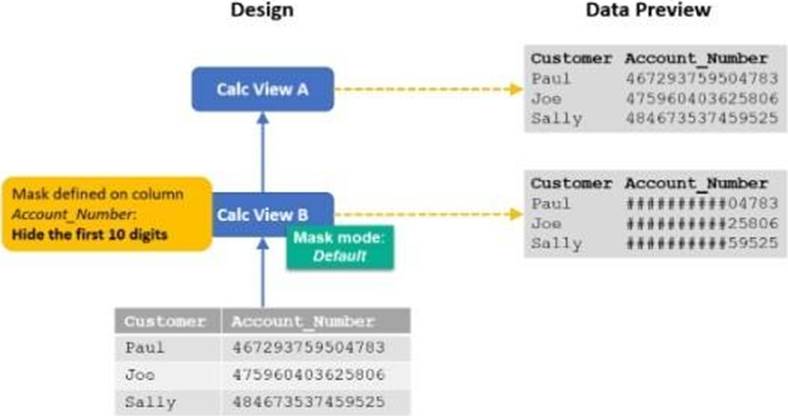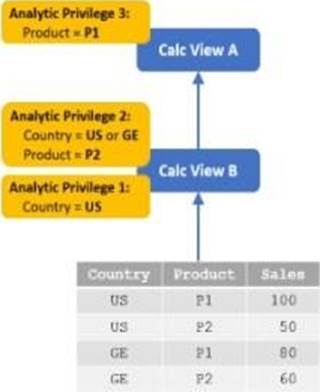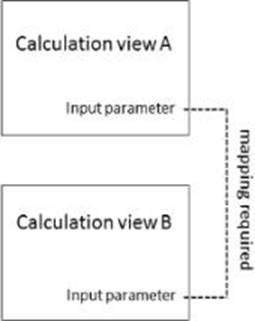SAP C_HANAIMP_18 SAP Certified Application Associate – SAP HANA 2.0 SPS06 Online Training
SAP C_HANAIMP_18 Online Training
The questions for C_HANAIMP_18 were last updated at Dec 11,2025.
- Exam Code: C_HANAIMP_18
- Exam Name: SAP Certified Application Associate - SAP HANA 2.0 SPS06
- Certification Provider: SAP
- Latest update: Dec 11,2025
You are building a new calculation view A that uses calculation view B, as shown in the diagram. When you preview the calculation view A, the Account Number is not masked.

What could be the reason?
- A . You previewed the data with the technical user in SAP Web IDE for SAP HANA.
- B . You did not define masking in calculation view A.
- C . The UNMASKED privilege for calculation view A has been granted.
- D . Analytic privilege _SYS_BI_CP_ALL has been assigned.
What are the consequences of NOT executing a delta merge? Note: There are 2 correct answers to this question.
- A . Aggregates are not adjusted.
- B . New records are not read.
- C . Read performance decreases.
- D . Memory is not optimized.
What are the limitations of using a full outer join in a star join node? Note: There are 2 correct answers to this question.
- A . It must appear in the last DIMENSION in the star join node.
- B . It CANNOT be mixed in the same star join node with other join types.
- C . Only one column can be included in the join condition.
- D . It is restricted to one DIMENSION in a star join node.
What is a restricted measure?
- A . A measure that cannot be referenced by a calculated column.
- B . A measure that can only be displayed by those with necessary privileges.
- C . A measure that is filtered by one or more attribute values.
- D . A measure that can be consumed by a CUBE and not a DIMENSION.
You created a table and inserted data in it using SQL statements inside the SAP HANA Deployment Infrastructure (HDI) container of your project. You add this table as a data source to a calculation view and try to build it.
What do you observe in the SAP HANA database container?
- A . The build fails and the table is dropped.
- B . The build fails and the table is not dropped.
- C . The build is successful and the data preview returns expected data.
- D . The build is successful but the data preview returns an error message.
In a calculation view, what is the purpose of a variable?
- A . To provide a dynamic value in a calculated column
- B . To break up complex SQL into smaller steps
- C . To filter an attribute at run-time based on a user input
- D . To pass values between procedures and calculation views
Two calculation views, A and B, are defined as shown in the diagram. Three analytic privileges have been granted to you.

When you preview calculation view A, what data do you see?
- A . US for P1 and P2, and GE for P2
- B . US for P1 and GE for P1
- C . US for P1
- D . US for P1 and P2, and GE for P1 and P2
You want to map an input parameter of calculation view A to an input parameter of calculation view B using the parameter mapping feature in the calculation view editor. However, the input parameters of calculation view B are not proposed as source parameters.

What might be the reason for this?
- A . You selected the wrong parameter mapping TYPE.
- B . Your source calculation view is of type DIMENSION.
- C . The names of the input parameters do not match.
- D . You already mapped the input parameters in another calculation view.
Why would you set the "Ignore multiple outputs for filters" property in a calculation view?
- A . To ensure semantic correctness
- B . To force filters to apply at the lowest node
- C . To hide columns that are not required
- D . To avoid duplicate rows in the output
Why would you create a multistore table?
- A . To implement a table that combines the features of row and column store
- B . To enable partitioning of the table across different storage tiers
- C . To improve read performance when the table is accessed by simultaneous applications
- D . To evenly distribute the data across all available server nodes
Latest C_HANAIMP_18 Dumps Valid Version with 80 Q&As
Latest And Valid Q&A | Instant Download | Once Fail, Full Refund

